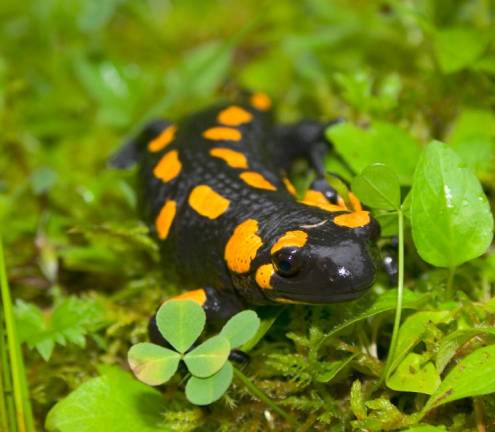Early salamander and frog migration expected this year

GOSHEN — Community volunteers throughout the Hudson Valley are getting out their raingear and clipboards in anticipation of annual breeding migrations of salamanders and frogs, the New York State Department of Environmental Conservation (DEC) announced.
The volunteers will be documenting their observations as part of DEC's Amphibian Migrations and Road Crossings Project. With this week's unseasonably warm temperatures and the rainy weekend forecast, the 2017 migration may have an unusually early start.
After the ground has started to thaw in late winter and early spring, species such as spotted salamander and wood frog emerge from underground winter shelters in the forest and walk overland to woodland pools for breeding. In New York, this migration usually occurs on rainy nights in late March and early April, when the night air temperature is above 40 degrees. When these conditions align just so, there can be explosive ("big night") migrations, with hundreds of amphibians on the move, many having to cross roads.
"New York hosts an incredible array of amphibians, and an even more amazing volunteer network that helps ensure their survival each spring," said DEC Commissioner Basil Seggos. "As the State's Wildlife Action Plan identifies road mortality as a significant threat to frogs, toads, and salamanders, I encourage all New Yorkers and visitors traveling through our state to keep an eye out for amphibians, and our committed community of volunteers helping them cross the road."
Volunteers of the Amphibian Migrations and Road Crossings Project document Hudson Valley locations where migrations cross roads, record weather and traffic conditions, and identify and count the salamanders, frogs, and toads on the move. The volunteers also carefully help the amphibians to safety cross roads. Now in its ninth year, more than 300 project volunteers have assisted more than 8,500 amphibians cross New York roads.
Drivers on New York roads are encouraged to proceed with caution or avoid travel on the first warm, rainy evenings of the season. Amphibians come out after nightfall and are slow moving; mortality can be high even on low-traffic roads.
For more information, visit Amphibian Migrations and Road Crossings on DEC's website or contact woodlandpool@dec.ny.gov. Project volunteers are encouraged to use the hashtag #amphibianmigrationhv in their photos and posts on social media.